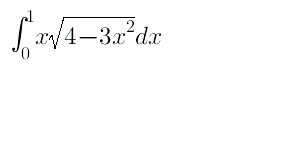
AllQuestion and Answers: Page 1763
Question Number 32900 Answers: 0 Comments: 0

Question Number 32897 Answers: 3 Comments: 0
$$ \\ $$$${e}^{\pi} \:>\:\pi^{{e}} \:\:{or}\:\:\:{e}^{\pi} <\pi^{{e}} \:? \\ $$$$ \\ $$
Question Number 32891 Answers: 0 Comments: 3

Question Number 32889 Answers: 0 Comments: 1

Question Number 32885 Answers: 1 Comments: 0

Question Number 32878 Answers: 1 Comments: 0
Question Number 32877 Answers: 1 Comments: 0
Question Number 32872 Answers: 1 Comments: 0

Question Number 32870 Answers: 0 Comments: 0

Question Number 32869 Answers: 1 Comments: 1
Question Number 32850 Answers: 0 Comments: 1
$${evaluate} \\ $$$$\int_{\mathrm{0}} ^{\pi} \mathrm{42}\left(\mathrm{2}\right){dx} \\ $$
Question Number 32868 Answers: 0 Comments: 0

Question Number 32845 Answers: 1 Comments: 0
Question Number 32844 Answers: 0 Comments: 1
Question Number 32841 Answers: 1 Comments: 0
Question Number 32837 Answers: 0 Comments: 1
Question Number 32838 Answers: 2 Comments: 2
Question Number 32834 Answers: 1 Comments: 0
Question Number 32832 Answers: 0 Comments: 0
Question Number 32830 Answers: 0 Comments: 0
Question Number 32810 Answers: 1 Comments: 2

Question Number 33004 Answers: 0 Comments: 3
Question Number 32965 Answers: 0 Comments: 2

Question Number 32960 Answers: 1 Comments: 0
Question Number 32789 Answers: 0 Comments: 0
Question Number 32788 Answers: 0 Comments: 1
Pg 1758 Pg 1759 Pg 1760 Pg 1761 Pg 1762 Pg 1763 Pg 1764 Pg 1765 Pg 1766 Pg 1767
